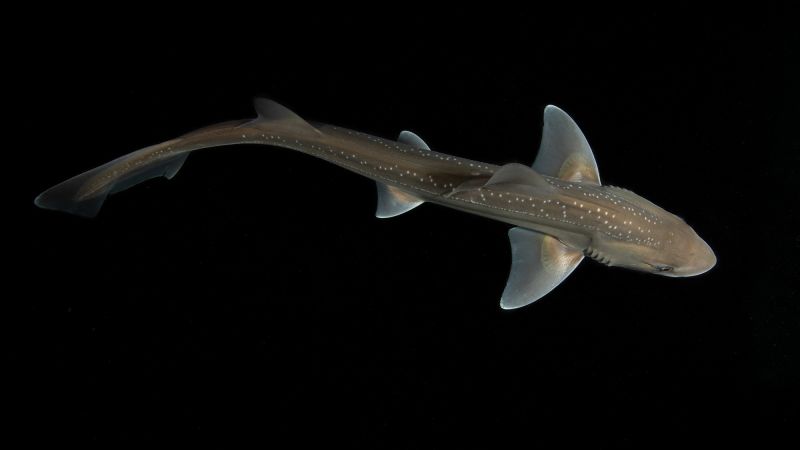Recent research has unveiled an astonishing discovery concerning the communication capabilities of the rig shark, scientifically known as *Mustelus lenticulatus*. The findings indicate that these sharks are capable of producing sounds by snapping their teeth, a revelation that could reshape our understanding of how sharks communicate. This discovery emerged from observations made by Dr. Carolin Nieder during her doctoral studies at the University of Auckland, where she noticed clicking sounds during behavioral training experiments. Her inquiry led to a detailed study that opened new avenues in shark research, allowing scientists to investigate how communication is maintained amongst over 500 shark species worldwide.
Contrary to the traditional view that sharks are silent hunters, the rig shark’s vocalizations were compared to the noise of a balloon popping. The researchers published their findings in the esteemed journal *Royal Society Open Science*. Neil Hammerschlag, president of the Atlantic Shark Expeditions and executive director of the Shark Research Foundation, highlighted the significance of these findings, noting that shark communication was previously thought to be limited to non-verbal body language or chemical signals. The new evidence suggests that vocalizations could play a more crucial role in the social interactions of sharks than initially believed.
Living primarily near the seabed of New Zealand’s coastal waters, the rig shark is a small species that plays an essential part in the region’s fishing industry. Unlike many other fish species, sharks do not possess swim bladders—organs that help fish control buoyancy and are also linked to sound production. This absence has historically made it difficult to ascertain how sharks might communicate acoustically. However, the research led by Nieder aimed to explore this overlooked aspect of shark behavior.
To conduct the study, Nieder and her team observed ten juvenile rig sharks, comprising an equal number of males and females, caught off New Zealand’s coast. They housed the sharks in appropriately maintained marine laboratory tanks between May 2021 and April 2022. The experimental setup involved transferring the sharks to individual tanks equipped with hydrophones for sound recording. During these transitions, researchers noted that the sharks would emit clicking noises similar to what Nieder had heard previously, with the clicks lasting around 48 milliseconds and reaching an impressive 156 decibels, powerful enough to be recognized by humans.
Throughout their observations, the researchers found that the clicks occurred predominantly within the first ten seconds following the handling of the sharks. Initially, these sharks produced an average of seven clicks during the first ten seconds, tapering to only two clicks in the final ten seconds of handling. This pattern indicated that the clicks might serve as a response to stress, possibly reflecting distress from being handled during the experiments. Over time, as the sharks acclimatized to their captivity and the routine experimental conditions, the clicking diminished, suggesting that their vocal behavior might not be random but rather intentional communication.
Interestingly, the data also indicated that approximately 70% of the clicks manifested when the sharks swayed gently from side to side, while a smaller percentage occurred during more dynamic movements such as vigorous head or body shakes. The researchers attribute these sounds to the strong interlocking nature of the rig shark’s teeth, which are notably flat and designed for crushing prey like crustaceans. This anatomical feature thus appears to facilitate the distinctive clicking sounds, paralleling similar noise-making methods used by other fish species.
Despite currently being unclear as to why rig sharks produce these sounds, researchers speculate that the clicks may serve functions related to communication or distress signaling. However, interestingly, most of the clicks fall outside the rig sharks’ own hearing capabilities, which peak around 800 hertz. This raises captivating questions about the potential implications of the sounds, such as if they act as alerts to nearby peers regarding the presence of predators or as signals of aggression within competitive feeding environments.
While this research has significantly expanded the understanding of environmental acoustics in the rig shark, it also lights a path for future investigations concerning the auditory behaviors of other shark species globally. Dr. Nieder believes there may be a possibility that other sharks might also exhibit similar vocal behaviors. The documentation could enrich the scientific community’s efforts to listen to and learn from sharks, thereby deepening the knowledge regarding their ecological roles and lifestyles.
As researchers move forward, the inquiry into whether rig sharks exhibit the same vocalizations in the wild remains a pressing avenue of exploration. Hammerschlag emphasized that this study paves the way for pondering the broader implications of sound-making in smaller sharks and what it might reveal about their interactions as they navigate their ecosystems. Such exploration not only enhances scientific understanding but also prompts conservation efforts aimed at protecting these vital ocean predators amidst ongoing environmental challenges.












